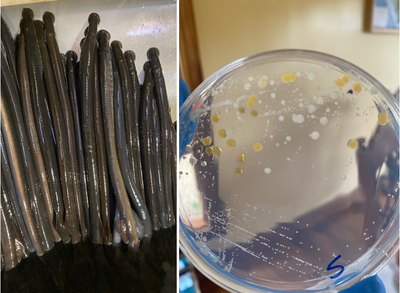Lamprey disease investigation: baseline survey in Tasmania

Kate Hutson (Cawthron Institute, Aotearoa|New Zealand) and the Inland Fisheries Service, Tasmania are working together to better understand the diseases of the pouched lamprey, Geotria australis, as part of a New Zealand based research programme, Emerging Aquatic Diseases.
In New Zealand, the pouched lamprey (kanakana) are susceptible to “lamprey reddening syndrome” which typically causes skin abnormalities around the gills, bodies and fins and has been associated with morbidity and mortality of lamprey returning to freshwater to spawn. The species comprises an important customary fishery for Māori and is considered a taonga (treasured) species, however, lamprey populations have diminished, and the species is listed Threatened – Nationally Vulnerable. Outbreaks of lamprey reddening syndrome have occurred in NZ since 2011.
A similar haemorrhagic skin condition was previously reported on G. australis in Western Australia in the late 1970s, but the extent of the disease in Australia is currently unknown. Observation and counts of lamprey in the River Derwent by the Inland Fisheries Service, Tasmania, indicate a robust and healthy population.
Despite disease investigations into mortality events in NZ and recent research efforts, the cause of lamprey reddening syndrome remains unknown. Cawthron are collaborating with Hokonui Rūnanga, Kitson consulting, iwi, University of Otago, University of Queensland, Plant and Food Research, Department of Conservation, and the Ministry for Primary Industries (MPI) in New Zealand who are researching the syndrome. One of the key challenges to understanding this disease has been a paucity of quality samples available for study and limited knowledge of diseases that affect lamprey.
The Tasmanian lamprey population provides a unique opportunity to better understand lamprey diseases and comparison with the NZ population can help identify differences between presumably healthy and diseased populations.
A baseline survey of lamprey from the River Derwent in Tasmania was organised. Here, the Inland Fisheries Service monitor a fish trap to enable fish moving upstream to navigate past the Meadowbank Lake Power Station (hydroelectric power). The evening prior to sampling, more than 200kg of lamprey had run up the river and were in the trap. Here, a representative sample of presumably healthy individuals were used to establish a baseline understanding of bacterial, viral, fungal, and parasitic fauna using a combination of traditional and molecular techniques. Specific results are pending molecular testing.
If you would like to hear more about this research, please be in touch with either Kate (kate.hutson@cawthron.org.nz) or Jonah (Jonah.Yick@ifs.tas.gov.au).